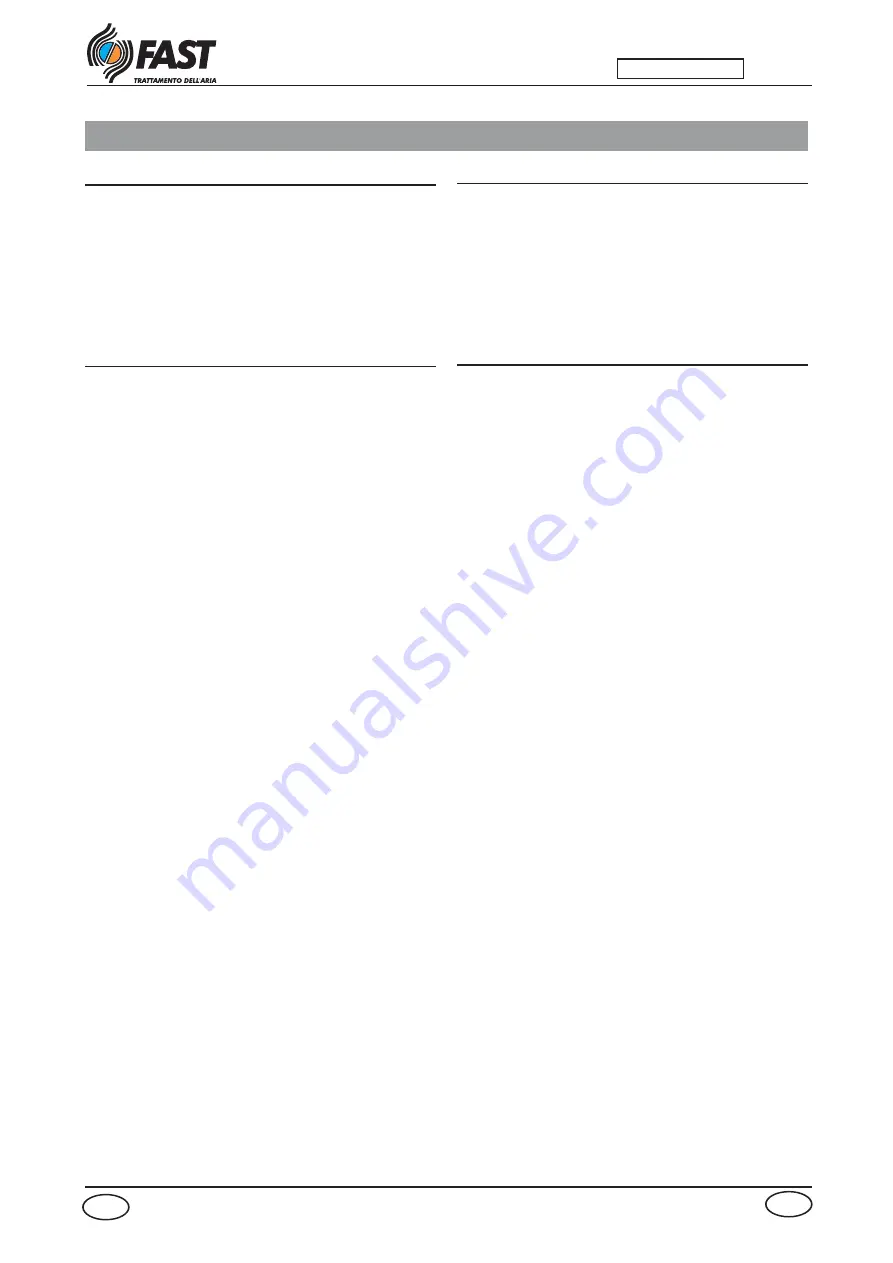
Unità roof-top small •
Roof-top small units
-
RTS
-
0605-6180610-rev. 1
Manuale di selezione e installazione
49
GB
Selection and installation manual
I
INSTALLAZIONE E UTILIZZO DELL’UNITÀ •
UNIT INSTALLATION AND USE
MOVIMENTAZIONE
Prima di movimentare l’unità accertarsi che non abbia subi-
to danni durante il trasporto e verificare che le attrezzature
da utilizzare per il sollevamento e posizionamento siano
adeguate come portata (vedi tabella pesi) e rispettino le
norme di sicurezza vigenti.
Particolare attenzione va posta a tutte le operazioni di cari-
co, scarico e sollevamento onde evitare situazioni di perico-
lo per le persone e danneggiamenti alla carpenteria ed agli
organi funzionali della macchina.
I pesi e gli assi del baricentro dell’unità sono indicati in tabella.
I fori del basamento da utilizzare per il sollevamento sono
evidenziati con adesivi gialli raffiguranti una freccia nera.
I pali, adeguatamente dimensionati, devono sporgere dal basa-
mento per una lunghezza tale che le cinghie di sollevamento
possano essere tese verso l’alto senza incontrare interferenze.
Accertarsi che le cinghie siano omologate per sopportare il peso
dell’unità, fare attenzione che siano ben fissate al telaio superio-
re ed ai pali di sollevamento, le chiusure di sicurezza devono
garantire che le cinghie non fuoriescano dalla loro sede.
Il telaio di sollevamento deve avere il punto di aggancio
sulla verticale del baricentro.
Il posizionamento può essere fatto utilizzando due transpal-
let uno per ogni lato della sezione, preferibilmente agendo
sui lati più lunghi.
Alternativamente il posizionamento può essere fatto facen-
do scorrere il rooftop su tubi con funzione di rulli.
Durante il sollevamento si consiglia di montare i supporti anti-
vibranti (AVX o VT), fissandoli ai fori ø 40 mm sul basamento,
secondo lo schema di montaggio a corredo degli accessori
(AVX o VT).
É assolutamente vietato sostare sotto l‘unità.
IMBALLO
Le unità della serie RTS vengono abitualmente fornite senza
imballo, fatta eccezione per le celle filtranti di efficienza
alta e per gli accessori di montaggio che vengono forniti
in scatole di cartone e da installare a cura del cliente. A
richiesta le centrali possono essere fornite imballate con
film di polietilene, su film di polietilene, in gabbia o
in cassa.
HANDLING
Before moving the unit, make sure that it has not suffered any
damage during transport and that the lifting and positioning equi-
pment to be used has an adequate capacity (see table of weights)
and that it complies with current safety regulations. Particular care
must be taken during all loading, unloading and lifting operations,
to avoid potential danger to people, damage to carpentry works
and damage to the working parts of the unit.
The unit weight and axes of the center of gravity are indicated in
the table. The lifting holes in the base are marked with adhesive
labels showing a black arrow on a yellow ground.
The lifting forks must be of a suitable size, and must protrude
from the base by a length sufficient to allow the lifting cables to
be raised from above without encountering any type of inter-
ference. Make sure that the belts are capable of bearing the
full weight of the unit, ensure they are firmly fixed to the upper
frame and to the lifting forks, the safety fastenings must ensure
that the belts do not come out of their housing. The lifting frame
connection point must be vertical to the center of gravity.
The positioning may be done by using two pallets, one for
each side of the section, preferably acting on the longest side.
Alternatively the positioning may be done by sliding the roof-
top on the tubes, which then act as rollers.
During lifting it is recommended that the vibration damper moun-
ts are installed (AVX or VT), fitting them to the ø 40mm holes in
the base, according to the assembly diagram supplied with the
accessories (AVX or VT).
Never stand underneath the unit.
PACKAGING
The units in the RTS series are usually supplied without packa-
ging except for the high or absolute efficiency filtering cells
and for the assembly accessories which are supplied in car-
dboard and are to be installed by the customer. On request,
the equipment may be supplied packed in polythene film, on
p polythene, in crates or cages.








































